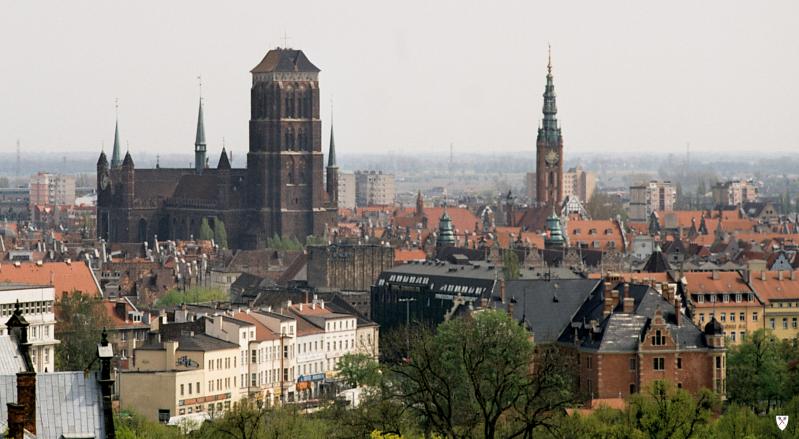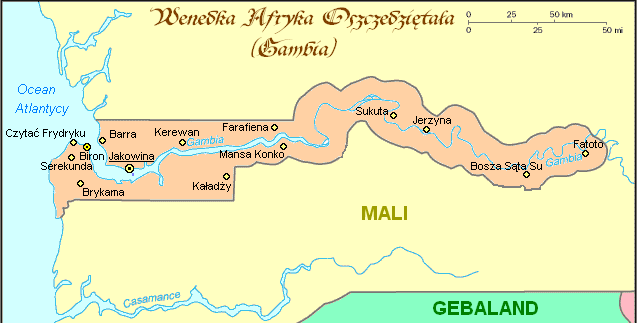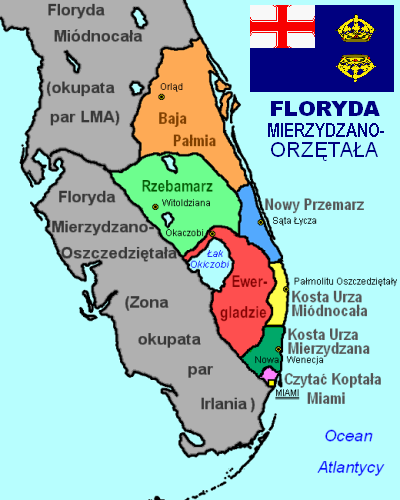
czytać", or "Three-city", consisting of Danzig, Zoppot and Gdynia.
 |
| Map of the Free City of Danzig. The orange part is the so-called "Trzy- czytać", or "Three-city", consisting of Danzig, Zoppot and Gdynia. |
Danzig [da:ntsiçk / danzik / da:nziç] is a city that is independent territory, but its defence and foreign affairs are managed by the Republic of the Two Crowns. It has been fully independent since 1948, partially in 1454-1793 and 1807-1939. Danzig is a full member and co-founder of the Baltic League. Official language of the city is Low Saxon.
Its full name is: Free City of Danzig (or: Freye Stadt Dantzig (in Low Saxon), Freie Stadt Danzig (in German), Liwra Czytać Gdańcyk (in Wenedyk).
Danzig is a coastal city with its climate moderated somewhat by the sea. It covers an area of 1,894 km². The territory of the Free City of Dantzig is entirely enclosed by the Baltic Sea in the north and the Republic of the Two Crowns elsewhere. Except for Danzig proper, which also acts as a capital of the Free City, it includes the town of Zoppot and several villages.
Before Danzig was established, the vicinity was inhabited by various populations. Referring to the coast, Iordanes mentions "Gothiscandza", and also Tacitus referred to the region in his Germania. Both historians believed the area to be populated. The first mentioning of the city itself dates back to 997, when Adalbert von Prag mentions a Slavic settlement called "Gydannyzc", located in a territory that would later become known as Preimern (Przemarz, Premaria).
The Duchy of Preimern was a Venedic fief, which formally became part of the Kingdom of Veneda in 1138. Danzig was its administrative center, and in 1224 it was granted the Lübeck rights. As more and more merchants from the Hansa cities of Lübeck and Bremen settled in Danzig, it rose to become one of the more important trading and fishing ports along the Baltic Sea coast. In 1361 it became a full member of the Hansa.
Veneda's hegemony over Danzig ended in 1308, when it was conquered by the Teutonic Order, along with the eastern half of Preimern. This would lead to a temporary reduction of Danzig's significance in the region. In 1454, Danzig joined the neighbouring Hanseatic cities of Elbing (now Elbiądz) and Thorn (now Turoń) in a rebellion against the Teutonic knights. This resulted in the Thirteen Years War (a.k.a. the War of the Cities), which ended with the Order's defeat and its surrender to the Venedic crown. The territory around Danzig now became part of Veneda, known as "Venedic", or "Royal" Prussia, while Danzig itself became a city republic under the suzerainty of the king of the Republic of Both Nations. Once more, Danzig flourished as a trading city, and after the Øresund incident it became one of the founding members of the Baltic League.
In the First partition of the RTC, Royal Prussia was annexed by Prussia and became known as West Prussia. Danzig became an enclave separated from the RTC, but remained under its sovereignty. However, in 1793 the Second partition of the RTC took place: Danzig was forced to give up its autonomy and became annexed by the Prussia as well.
 |
This situation would not last long, though. With the help of Napoleon, emperor of France and king of the RBN, Danzig once more became a free city in 1807, and it remained so when the Vienna Congress confirmed the status quo as it had existed before 1793. This would be the beginning of a relatively quiet period, and during the whole 19th century, little would change for Danzig.
Initially, neither the Republic of Both Nations nor Danzig was affected by the First Great War. This would change in 1915, when the Republic finally declared on Germany. Within a short notice of time, it was completely overrun by the combined German/Hungarian forces, and when the war was finally concluded in 1918, the Republic of Both Nations ceased to exist. The Kingdom of Veneda became a rump state, only allowed to continue its existence as a German satellite state, while Lithuania became an – equally pro-German – kingdom. Danzig remained a Free State, so nominally nothing changed; but in reality, with the Republic's protection gone, it de facto became a German protectorate within the Holy Roman Empire. Shortly after the outbreak of the Second Great War in 1939, it would be fully incorporated into Prussia.
After the war, in 1948-1949, both the Free City of Danzig and the Republic of Both Nations were restored, the latter as the Republic of the Two Crowns. Danzig's territory was expanded to its current borders. Since then, the two countries have been closely connected to each other: the RTC is partly responsible for Danzig's defense, and their currencies (the Danziger gulden and the Republic's talar) are linked at a stable 1:1 rate.
Danzig is a parliamentary democratic republic. The head of state (the Upper Mayor) is appointed by the fourteen-member council of Danzig (the Senate) for a five-year term (maximum: two terms), and the President of the Senate (head of government) is elected by the people, normally every four years. The President represents the city in European affairs, and the general powers of the political leaders are shared with the Republic of the Two Crowns' ministers. The Danzig government cannot declare war or discommunication (i.e., ending relations with other countries) unless the RTC's government approves also. If they do not, and Danzig goes ahead, a referendum has to be held in both RTC and Danzig. Economically, Danzig is independent of the RTC, but their currencies are connected on a 1:1 base. Danzig's currency is the gulden, subdivided into 30 groschen, 90 schilinge or 540 penninge.
The current Upper Mayor is Holger Bolle, president of the Senate is Angela Urtenbraugen.


Danzig is inhabited by ca. 500,000 people, most of whom are speakers of Low Saxon, the city's official language. There is also a sizeable population of Germans, Veneds, and Kashubs. The population of the free city and its surrounding territories consists roughly for 35 % of Roman Catholics, for 35 % of Lutherans, for 20 % of Jews, for 5 % of pagans, and for 5 % of adherents of other religions and persons without any religious affiliation.
 |
| Flag of Venedic West-Africa |
The Gambia, also known as Wenedka Afryka Oszczedziętała (Venedic West-Africa), Gwineja Wenedka (Venedic Guinea), Wenedka Afryka Zgambiana (Venedic Gambian Africa), and Wenedcze Cierze Zgambianie (Venedic Gambian Lands) is a nation in West Africa. It covers an area of 10,380 km² (11.5 % of which is water), thus making it one of the smallest countries within the African continent. It is entirely surrounded by the Senegal region of Mali, with the Gambia River emptying into the Atlantic Ocean in its center. Nominally an independent state, Gambia is actually an overseas territory of the Republic of the Two Crowns, whose king is represented in Gambia by a governor. The incumbent governor is former RTC chancellor Żowan Krzysztof Albin-Ałbodurzyn.
Jakobina is its capital and, with 255,000 inhabitants, the largest city of Gambia. Other significant cities and towns are: Serekunda (102,000), Biron (50,000), Brykama (24,000), Czytać Frydryku (20,000), Farafiena (10,000), and Sukuta (7,000).
Gambia is inhabited by 1,367,000 people (2000 census). The official language is Wenedyk, other languages spoken in Gambia are Mandinka, Wolof, and Fula.

 |
| Administrative map of Southeast Florida, published by the RTC's occupational forces |
In March 2004, the state of Florida-Caribbea on the North American continent was defeated and shattered in a short war, the 2004 War, also known as the Florida War. The direct reason for the war had been the Cruzan Islands' declaration of independence, although in reality the war had been in the making for much longer. A coalition of the Federated Kingdoms, the North-American League, the Scandinavian Realm, Ireland and the RTC intervened quickly and put a definitive end to the huge state of Florida-Caribbea. Florida proper was subdivided into three occupation zones: North Florida was occupied by the NAL, Southwest Florida by Ireland, and Southeast Florida by the Scandinavian Realm. Shortly thereafter, Scandinavia handed over its zone of occupation to the Republic of the Two Crowns.
From that moment on, the RTC has done its best to prepare the population of the former banana republic for a transition towards a democratic constellation, simultaneously fighting rebellious pockets of supporters of former dictator Jaime Bush and his successor, colonel Silva-Gonzales. While the Northern zone was quickly transformed into two brand-new NAL provinces, West and East Florida, the two European zones of South Florida managed to avoid such fate. The Irish zone soon disintegrated, falling apart into several tiny mini-states, but the RTC has managed to keep its zone together, leading it towards a better future.
The first person to be in charge of the RTC's Zone of Occupation was the commander-in-chief of its armed forces in Florida, future chancellor Marek Aldendorf. Already in March 2004, the government decided to hand over power to an administration of civilians, headed by the RTC's former ambassador to Florida-Caribbea, Katarzyna Prowana. In July 2006, she was replaced as Head of the Civic Administration in Southeast Florida by general Jużeń Bambaryła, who styles himself "governor-general".
During the period of Lithuania's existence as an independent state, in the 1920s and 1930s, it developed an ambitious colonial program, which started later and ended earlier than that of most other countries, and in itself was quite unique. The first ideas to acquire colonies came during the time of "nationalist" rule, and were promoted largely by geographer and intellectual Kazys Pakštas. By his views, Lithuania at the time could not remain long, wracked as it was with internal conflicts and surrounded by so many mighty countries. In order to protect at least a portion of Lithuanian culture, which he felt was in danger, he suggested colonization. By establishing colonies, the outflow of increasing emmigration from Lithuania to the Americas and other places would be directed, creating an "emergency Lithuania", a country populated by Lithuanians should Lithuania itself would be taken by Russians, Germans, fall into another union with Veneda (which Pakštas saw as foreign occupation), or have its government overthrown by Belarussians. In this way, should such evils arise, the "emergency Lithuania" would be a stronghold of Lithuanian culture and would maintain the wishes of Lithuania should it be occupied a foreign power.
This policy led to the existence of three large Lithuanian communities outside Lithuania proper:
— one in Tejas, which however never experienced the growth in population Pakštas had hoped for;
— one in the African Maasai country, which let to the existence of a short-lived state of Pakštuva during the years 1940-1942;
— and Free Lithuania on Antarctica, which exists until today.